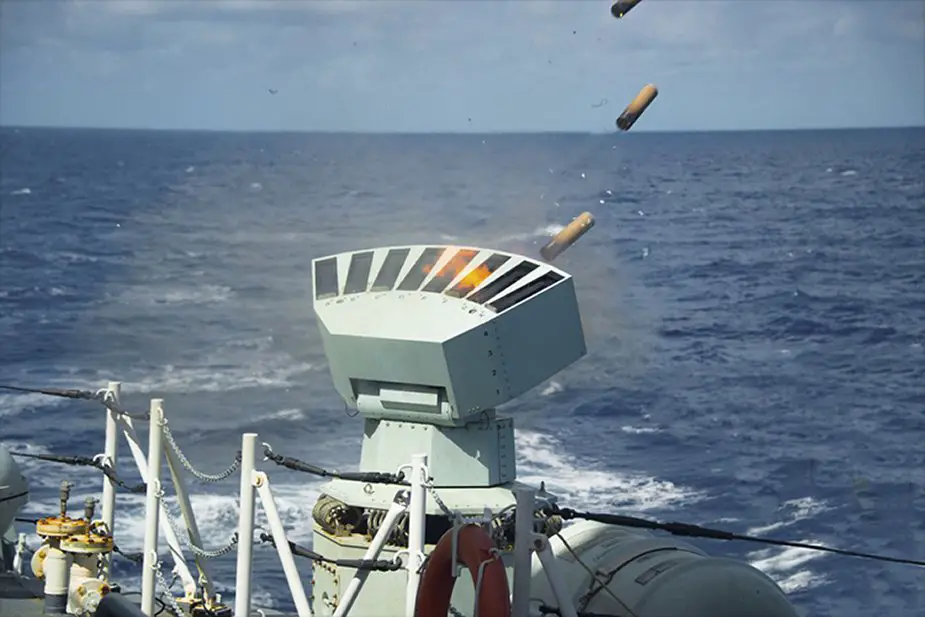Breaking news
Rheinmetall to equip Australia Navy's warships with Multi Ammunition Softkill System.
According to a PR published by Rheinmetall on May 5, 2023, the company has secured a significant order in the maritime protection systems field, as the Royal Australian Navy and the Commonwealth of Australia have chosen the Multi Ammunition Softkill System (MASS) to equip their Hobart-class destroyers and ANZAC-class frigates.
Follow Navy Recognition on Google News at this link
 Multi Ammunition Softkill System or MASS. (Picture source: Rheinmetall)
Multi Ammunition Softkill System or MASS. (Picture source: Rheinmetall)
MASS was chosen due to its exceptional capabilities following extensive trials. The order represents €125 million in sales for Rheinmetall, and the first systems are set to be delivered by the end of 2023, with full operational capacity reached by 2027.
This is Rheinmetall's largest-ever order for ship protection technology, and the contract includes an option to equip the entire Australian fleet, which could result in a total sales volume of A$1 billion (about €610 million).
The transfer of MASS technology means Rheinmetall Defence Australia will be able to produce the systems under license, and the systems will be assembled at Rheinmetall Defence Australia’s MILVEHCOE center of excellence for military vehicles.
The MASS system offers unique protection against multifaceted threats, including modern sensor-guided missiles and laser-guided weapons, and can be installed on vessels of all sizes, integrated into existing shipboard systems, or operate as a standalone system.
The standard version of MASS includes up to six trainable launchers, each capable of firing 32 Omni Trap decoy munitions, and Rheinmetall is continuously improving its MASS family to provide the best possible protection to ships and their crews operating in the high seas and coastal waters.
About the Hobart class destroyer
The Hobart-class destroyer is a guided-missile destroyer type with a full load displacement of 7,000 tonnes (6,900 long tons; 7,700 short tons). It is 147.2 meters (483 ft) long and has a maximum beam of 18.6 meters (61 ft) and a draught of 5.17 meters (17.0 ft).
The ship has a Combined diesel or gas (CODOG) propulsion arrangement with 2 × General Electric Marine model 7LM2500-SA-MLG38 gas turbines and 2 × Caterpillar Bravo 16 V Bravo diesel engines.
She has a speed of over 28 knots (52 km/h; 32 mph) and a range of over 5,000 nautical miles (9,300 km; 5,800 mi) at 18 knots (33 km/h; 21 mph). The ship has a complement of 186 + 16 aircrew with accommodation for 234.
The Hobart-class destroyer is equipped with various sensors and processing systems, including the Aegis combat system, Lockheed Martin AN/SPY-1D(V) S-band radar, Northrop Grumman AN/SPQ-9B X-band pulse Doppler horizon search radar, Raytheon Mark 99 fire-control system with two AN/SPG-62 continuous wave illuminating radars, 2 × L-3 Communications SAM Electronics X-band navigation radars, Ultra Electronics Sonar Systems, hull-mounted sonar, and towed sonar.
The ship also has electronic warfare and decoys such as the ITT EDO Reconnaissance and Surveillance Systems ES-3701 ESM radar, SwRI MBS-567A communications ESM system, Ultra Electronics Avalon Systems multipurpose digital receiver, Jenkins Engineering Defence Systems low-band receiver, 4 × Nulka decoy launchers, and 4 × 6-tube multipurpose decoy launchers.
The armament of the destroyer includes a 48-cell Mark 41 Vertical Launch System, 2 × 4-canister Harpoon missile launchers, 1 × Mark 45 (Mod 4) 5-inch gun, 2 × Mark 32 Mod 9 two-tube torpedo launchers, Eurotorp MU90 torpedoes, 1 × Phalanx CIWS, and 2 × 25mm Mk 38 M242 Bushmaster autocannons in Typhoon mounts. She can also carry 1 × MH-60R Seahawk aircraft.




























